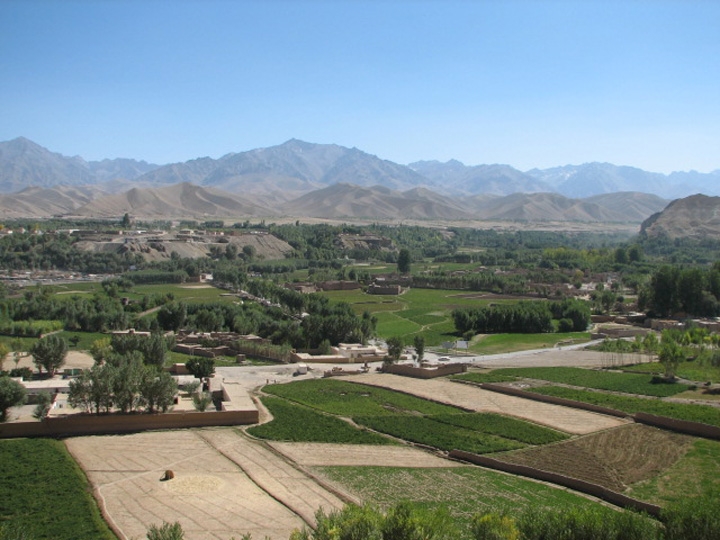By Sune Engel Rasmussen, The Guardian
The central highlands of Afghanistan are a world away from the congested chaos of the country’s cities. Hills roll across colossal, uninhabited spaces fringed by snow-flecked mountains, set against blistering blue skies.
In this spectacular, harsh landscape, one can pinpoint more or less where human settlement becomes impossible: at an altitude of 3,000 meters (9,840 feet).
This is where Aziza’s family lives, in the village of Borghason. In a good year, they just about survive by cultivating wheat and potatoes for food and a small income. However, when the rains fail, as they increasingly do, the family is plunged into debt, unable to reimburse merchants for that year’s seeds. “Last year, we had to borrow money from the bazaar,” Aziza says.
Things are about to get tougher. The precariousness of life in Bamiyan, one of Afghanistan’s poorest provinces, leaves villages like Borghason at the mercy of climate change.

At 9,840 feet, farmers in Shah Foladi can grow wheat and potatoes. Above that altitude, the terrain becomes uninhabitable.
Credit: Tracy Hunter/flickr
On a recent visit, the Guardian trekked from freshwater lakes surrounded by jagged massifs at 4,500 meters (14,760 feet) down to villages at the receiving end of erratic weather, a common result of global warming. Warmer temperatures melt the mountain snow earlier, resulting in an increased flow of water before farmers need it.
These are irregularities that farmers living at the margins of economic sustainability cannot afford. “People are surviving,” says Andrew Scanlon, country director for the UN Environment Programme (UNEP). “[But] their ability to bounce back is almost zilch.”
Farmers say unanimously that temperatures have risen over the past decades. Rain is scarcer and more unpredictable. “People know about climate change even if they don’t call it that,” says Fatima Akbari, the UNEP’s country assistant. “They know all about change in water and weather.”
Despite 15 years as one of the world’s biggest receivers of international aid, much of it to agriculture, Afghanistan remains woefully underdeveloped and largely defenceless against jolts from nature. Western donors primarily poured money into short-sighted programmes such as heavy engineering and cash-for-work schemes, designed for “quick impact”, Scanlon says.
“Soldiers and engineers were on six-month contracts and needed to quickly win hearts and minds,” he adds. Governments and engineers got accustomed to short time frames. Meanwhile, little was done to build long-term resilience. Winning hearts and minds was meant to win the war, yet climate change endangers that elusive victory.
Although research on the topic in Afghanistan is limited to small-scale anthropological analyses, studies from Iraq and elsewhere link global warming and security. According to the UNEP, about 80 percent of conflicts in Afghanistan are related to resources like land and water — and to food insecurity, an immediate consequence of global warming.
According to a report by the UNEP, the World Food Programme and the National Environmental Protection Agency (NEPA), the biggest climate hazards to Afghan livelihoods are drought and floods, caused by irregular snowmelt or rainfall.
Bamiyan is the epicentre. The mountains in Shah Foladi, one of four recognised national parks, feed both the Kabul basin and the Helmand river, which runs south for 700 miles. In Helmand, water has instigated conflict for decades and been central to foreign intervention since the early cold war, when the U.S. got involved in irrigation projects.

The mountains in Shah Foladi, in Afghanistan’s Bamiyan province, feed both the Kabul basin and the Helmand river.
Credit: Carlos Ugarte/flickr
Despite fighting a worsening war against insurgents, the Afghan government seems, to an extent, aware of the need to address the risks of global warming. “In the region, Afghanistan is the most vulnerable country facing the ravages of climate change,” says Prince Mostapha Zaher, grandson of the former king Mohammad Zahir Shah and director general of the NEPA.
Zaher, a trained microbiologist and a forceful presence, has entered Afghanistan into 14 international environmental conventions since 2005. Still, the government’s priorities appear to fall short of his ambitions. Zaher describes the NEPA, which is not an actual ministry, as a “fledgling agency on a shoestring budget”.
He has spearheaded efforts to protect Afghanistan’s extraordinary biodiversity by helping to name four areas as national parks. In June, marking World Environment Day, a wetlands site inside the city of Kabul became the latest. Kol-e-Hashmat Khan is a stopover for migratory birds of “world-class importance” and is visited by 150 species each year, according to the UNEP.
Threats to the site come not just from the climate but from humans, too. Garbage is piled high on the water’s edge. One-fourth of the site’s nearly 200 hectares have been grabbed by “strongmen”, who burn reeds and erect cream-coloured villas jutting from the banks. “Afghanistan is one of the most biodiverse countries in the world,” says Scanlon, adding that the country boasts about 3,000 endemic plants, almost four times more than Europe.
National biodiversity is another victim of international donors, such as USAid, that subsidise fertiliser and pesticides to Afghan farmers, and have used pesticides to eradicate poppies. Scanlon says international agencies generally have a “poor understanding” of Afghanistan’s natural riches. “I still speak to high-ranking officials from the World Bank, EU and other UN agencies who think Afghanistan is a desert, absolutely devoid of ecological value,” he adds.
In Bamiyan, the UNEP works to promote sustainable farming. In the village of Khoshgak, farmers used to cultivate the hills to take advantage of rainfall, but that drained them of all nourishment. Now, by collecting water in concrete basins fed by underground pipes, they grow apricots, barley and potatoes in the valley.
“Before, there was nothing here. It was scorched,” says Haji Qadir, a village elder, from his neatly manicured garden. Still, he remembers the valley of his childhood being more fertile. “The air used to be cleaner, not full of dust like now.”
Women are particularly affected by erratic weather. In Borghason, when the rains fail, farmers switch crops from barley to wheat, which is less ideal as livestock feed, says Chaman, an older woman in the village. As a result, women — who are tasked with fetching water and tending livestock ‚ have longer distances to hike.
Villages in Bamiyan exemplify how climate change can hamper the ability of families to sustain themselves. According to Prince Zaher, they show why global warming should be taken as seriously as fighting insurgents. “Terrorism is not going to be lingering here for ever,” he says. “But climate change is an ongoing death sentence.”
Reprinted from The Guardian with permission.
![]()

